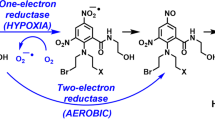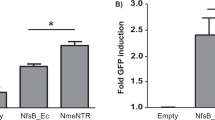Abstract
Viruses that replicate selectively in cancer cells constitute an exciting new class of anticancer agent. The conditionally replicating adenovirus (CRAd) dl1520, which lacks the E1B-55K gene, has elicited significant clinical responses in humans when used in combination with chemotherapy. A convergent development has been to use replication-defective viruses to express prodrug-activating enzymes in cancer cells. This can sensitize the cancer to prodrug, but depends upon achieving sufficient level, distribution and specificity of enzyme expression within the tumour. In this study, we have expressed the prodrug-activating enzyme nitroreductase (NTR) in the context of an E1B-55K-deleted adenovirus, CRAd-NTR(PS1217H6). We show that CRAd-NTR(PS1217H6) retains oncolytic growth properties, and expresses substantially more NTR than a comparable, replication-defective adenovirus. The combination of viral oncolysis and NTR expression results in significantly greater sensitization of SW480 and WiDr colorectal cancer cells to the prodrug CB1954 in vitro. In vivo, CRAd-NTR(PS1217H6) was shown to replicate in subcutaneous SW480 tumour xenografts in immunodeficient mice, resulting in more NTR expression and greater sensitization to CB1954 than with replication-defective virus. Combination therapy of CRAd-NTR(PS1217H6) with CB1954 reduced tumour growth from 13.5- to 2.8-fold over 5 weeks, and extended median survival from 42 to 81 days, compared with no treatment.
This is a preview of subscription content, access via your institution
Access options
Subscribe to this journal
Receive 12 print issues and online access
$259.00 per year
only $21.58 per issue
Buy this article
- Purchase on Springer Link
- Instant access to full article PDF
Prices may be subject to local taxes which are calculated during checkout









Similar content being viewed by others
References
Vile R, Ando D, Kirn D . The oncolytic virotherapy treatment platform for cancer: unique biological and biosafety points to consider. Cancer Gene Ther 2002; 9: 1062–1067.
Barker DD, Berk AJ . Adenovirus proteins from both E1B reading frames are required for transformation of rodent cells by viral infection and DNA transfection. Virology 1987; 156: 107–121.
Bischoff JR et al. An adenovirus mutant that replicates selectively in p53-deficient human tumor-cells. Science 1996; 274: 373–376.
Ries SJ et al. Loss of p14ARF in tumor cells facilitates replication of the adenovirus mutant dl1520 (ONYX-015). Nat Med 2000; 6: 1128–1133.
Kirn D . Clinical research results with dl1520 (Onyx-015), a replication-selective adenovirus for the treatment of cancer: what have we learned? Gene Therapy 2001; 8: 89–98.
Khuri FR et al. A controlled trial of intratumoral ONYX-015, a selectively-replicating adenovirus, in combination with cisplatin and 5-fluorouracil in patients with recurrent head and neck cancer. Nat Med 2000; 6: 879–885.
Reid T et al. Hepatic arterial infusion of a replication-selective oncolytic adenovirus (dl1520): phase II viral, immunologic, and clinical endpoints. Cancer Res 2002; 62: 6070–6079.
Huber BE et al. In vivo antitumor activity of 5-fluorocytosine on human colorectal carcinoma cells genetically modified to express cytosine deaminase. Cancer Res 1993; 53: 4619–4626.
Culver KW et al. Gene therapy for the treatment of malignant brain tumors with in vivo tumor transduction with the herpes simplex thymidine kinase gene ganciclovir system. Hum Gene Ther 1994; 5: 343–379.
Mullen CA, Kilstrup M, Blaese RM . Transfer of the bacterial gene for cytosine deaminase to mammalian cells confers lethal sensitivity to 5-fluorocytosine: a negative selection system. Proc Natl Acad Sci USA 1992; 89: 33–37.
Hamstra DA et al. Enzyme/prodrug therapy for head and neck cancer using a catalytically superior cytosine deaminase. Hum Gene Ther 1999; 10: 1993–2003.
Bridgewater JA et al. Expression of the bacterial nitroreductase enzyme in mammalian cells renders them selectively sensitive to killing by the prodrug CB1954. Eur J Cancer 1995; 31A: 2362–2370.
Green NK et al. Sensitization of colorectal and pancreatic cancer cell lines to the prodrug 5-(aziridin-1-yl)-2,4-dinitrobenzamide (CB1954) by retroviral transduction and expression of the E. coli nitroreductase gene. Cancer Gene Ther 1997; 4: 229–238.
Grove JI et al. Virus directed enzyme prodrug therapy using CB1954. Anti-Cancer Drug Des 1999; 14: 461–472.
Wildner O, Blaese RM, Morris JC . Therapy of colon cancer with oncolytic adenovirus is enhanced by the addition of herpes simplex virus-thymidine kinase. Cancer Res 1999; 59: 410–413.
Wildner O et al. Adenoviral vectors capable of replication improve the efficacy of HSVtk/GCV suicide gene therapy of cancer. Gene Therapy 1999; 6: 57–62.
Freytag SO et al. A novel three-pronged approach to kill cancer cells selectively: concomitant viral, double suicide gene, and radiotherapy. Hum Gene Ther 1998; 9: 1323–1333.
Rogulski KR et al. Double suicide gene therapy augments the antitumor activity of a replication-competent lytic adenovirus through enhanced cytotoxicity and radiosensitization. Hum Gene Ther 2000; 11: 67–76.
Knox RJ, Friedlos F, Boland M . The bioactivation of CB1954 and its use as a prodrug in antibody-directed enzyme prodrug therapy (ADEPT). Cancer Metast Rev 1993; 12: 195–212.
Weedon SJ et al. Sensitisation of human carcinoma cells to the prodrug CB1954 by adenovirus vector-mediated expression of E. coli nitroreductase. Int J Cancer 2000; 86: 848–854.
McNeish IA et al. Virus directed enzyme prodrug therapy for ovarian and pancreatic cancer using retrovirally delivered E. coli nitroreductase and CB1954. Gene Therapy 1998; 5: 1061–1069.
Djeha AH et al. Expression of E. coli B nitroreductase in established human tumour xenografts in mice results in potent anti-tumour and bystander effects upon systemic administration of the prodrug CB1954. Cancer Gene Ther 2000; 7: 721–731.
Djeha AH et al. Combined adenovirus-mediated nitroreductase gene delivery and CB1954 treatment: a well-tolerated therapy for established solid tumors. Mol Ther 2001; 3: 233–240.
Palmer D et al. Virus directed enzyme prodrug therapy: intratumoral administration of a replication-deficient adenovirus encoding nitroreductase to patients with resectable liver cancer. J Clin Oncol 2004; 22: (Published online 1st May 2004).
Steinwaerder DS, Carlson CA, Lieber A . DNA replication of first-generation adenovirus vectors in tumor cells. Hum Gene Ther 2000; 11: 1933–1948.
Heise CC, Williams A, Olesch J, Kirn DH . Efficacy of a replication-competent adenovirus (ONYX-015) following intratumoral injection: intratumoral spread and distribution effects. Cancer Gene Ther 1999; 6: 499–504.
Chung-Faye G et al. Virus-directed, enzyme prodrug therapy with nitroimidazole reductase: a phase I and pharmacokinetic study of its prodrug, CB1954. Clin Cancer Res 2001; 7: 2662–2668.
Searle PF, Spiers I, Simpson J, James ND . Cancer gene therapy: from science to clinical trials. Drug Deliv Systems Sci 2002; 2: 5–13.
Sausville EA . Genes in the service of therapeutic index: progress for virus-directed enzyme prodrug therapy. J Clin Onc 2004; 22: 1535–1537.
Turnell AS, Grand RJ, Gallimore PH . The replicative capacities of large E1B-null group A and group C adenoviruses are independent of host cell p53 status. J Virol 1999; 73: 2074–2083.
Edwards SJ et al. Evidence that replication of the antitumor adenovirus ONYX-015 is not controlled by the p53 and p14ARF tumor suppressor genes. J Virol 2002; 76: 12483–12490.
Boland MP, Knox RJ, Roberts JJ . The differences in kinetics of rat and human DT diaphorase result in a differential sensitivity of derived cell lines to CB1954 (5-(aziridin-1-yl)-2,4-dinitrobenzamide). Biochem Pharmacol 1991; 41: 867–875.
Green NK et al. Immune enhancement of nitroreductase-induced cytotoxicity: studies using a bicistronic adenovirus vector. Int J Cancer 2003; 104: 104–112.
Hawkins LK, Hermiston T . Gene delivery from the E3 region of replicating human adenovirus: evaluation of the E3B region. Gene Therapy 2001; 8: 1142–1148.
Nanda D et al. Treatment of malignant gliomas with a replicating adenoviral vector expressing herpes simplex virus-thymidine kinase. Cancer Res 2001; 61: 8743–8750.
Babiss LE, Ginsberg HS, Darnell Jr JE . Adenovirus E1B proteins are required for accumulation of late viral mRNA and for effects on cellular mRNA translation and transport. Mol Cell Biol 1985; 5: 2552–2558.
Wildner O, Morris JC . The role of the E1B 55 kDa gene product in oncolytic adenoviral vectors expressing herpes simplex virus-tk: assessment of antitumor efficacy and toxicity. Cancer Res 2000; 60: 4167–4174.
Heise C et al. An adenovirus E1A mutant that demonstrates potent and selective systemic anti-tumoral efficacy. Nat Med 2000; 6: 1134–1139.
Nettelbeck DM et al. Novel oncolytic adenoviruses targeted to melanoma: specific viral replication and cytolysis by expression of E1A mutants from the tyrosinase enhancer/promoter. Cancer Res 2002; 62: 4663–4670.
Coukos G et al. Oncolytic herpes simplex virus-1 lacking ICP34.5 induces p53-independent death and is efficacious against chemotherapy-resistant ovarian cancer. Clin Cancer Res 2000; 6: 3342–3353.
Rodriguez R et al. Prostate attenuated replication competent adenovirus (ARCA) CN706: a selective cytotoxic for prostate-specific antigen-positive prostate cancer cells. Cancer Res 1997; 57: 2559–2563.
Gallimore PH et al. Adenovirus type 12 early region 1B 54K protein significantly extends the life span of normal mammalian cells in culture. J Virol 1997; 71: 6629–6640.
Fallaux FJ et al. Characterization of 911: a new helper cell line for the titration and propagation of early-region-1-deleted adenoviral vectors. Hum Gene Ther 1996; 7: 215–222.
Berry IJ, Burns JE, Parkinson EK . Assignment of two human epidermal squamous cell carcinomas cell lines to more than one complementation group for the immortal phenotype. Mol Carcinogen 1994; 9: 134–142.
Latham JP, Searle PF, Mautner V, James ND . Prostate-specific antigen promoter/enhancer driven gene therapy for prostate cancer: construction and testing of a tissue-specific adenovirus vector. Cancer Res 2000; 60: 334–341.
Hirt B . Selective extraction of polyoma DNA from infected mouse cells. J Mol Biol 1967; 26: 365–369.
Stallwood Y, Fisher KD, Gallimore PH, Mautner V . Neutralisation of adenovirus infectivity by ascitic fluid from ovarian cancer patients. Gene Therapy 2000; 7: 637–643.
Acknowledgements
This work was supported by the UK Medical Research Council Grant G9806623. MJC acknowledges the support of Mackay Memorial Hospital, Taipei, Taiwan. We thank ML Laboratories plc. for CTL102, CB1954 and sheep anti-NTR antibody, and D Onion for Q-PCR analysis of CTL102 virus stocks.
Author information
Authors and Affiliations
Rights and permissions
About this article
Cite this article
Chen, MJ., Green, N., Reynolds, G. et al. Enhanced efficacy of Escherichia coli nitroreductase/CB1954 prodrug activation gene therapy using an E1B-55K-deleted oncolytic adenovirus vector. Gene Ther 11, 1126–1136 (2004). https://doi.org/10.1038/sj.gt.3302271
Received:
Accepted:
Published:
Issue Date:
DOI: https://doi.org/10.1038/sj.gt.3302271
Keywords
This article is cited by
-
Bioreductive prodrug PR-104 improves the tumour distribution and titre of the nitroreductase-armed oncolytic adenovirus ONYX-411NTR leading to therapeutic benefit
Cancer Gene Therapy (2022)
-
The use of hypoxic cultured mesenchymal stem cell for oncolytic virus therapy
Cancer Gene Therapy (2013)
-
Adenovirus-mediated hypoxia-targeted gene therapy using HSV thymidine kinase and bacterial nitroreductase prodrug-activating genes in vitro and in vivo
Cancer Gene Therapy (2011)
-
Minimal RB-responsive E1A Promoter Modification to Attain Potency, Selectivity, and Transgene-arming Capacity in Oncolytic Adenoviruses
Molecular Therapy (2010)
-
Armed replicating adenoviruses for cancer virotherapy
Cancer Gene Therapy (2009)



